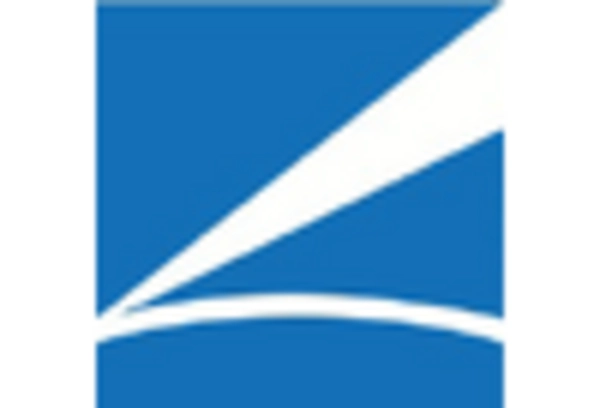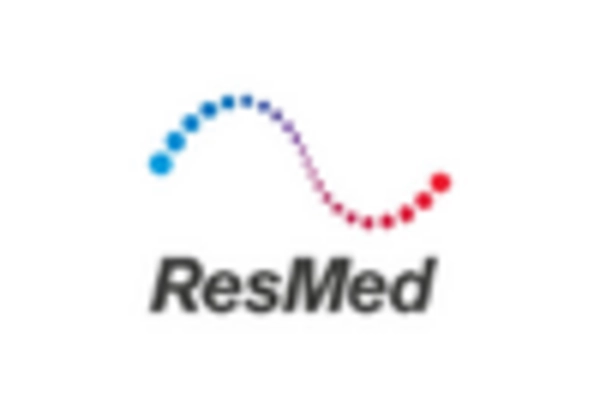Growing Aging Population
The Acoustic Respiration Sensor Market is significantly impacted by the growing aging population, which is more susceptible to respiratory ailments. As individuals age, the prevalence of chronic respiratory diseases such as COPD and asthma tends to increase, necessitating effective monitoring solutions. Current demographic trends indicate that by 2030, the number of individuals aged 65 and older is expected to reach 1.5 billion, creating a substantial market for respiratory health monitoring devices. Acoustic respiration sensors offer a non-invasive and user-friendly approach to track respiratory health, making them particularly appealing for elderly patients. This demographic shift is likely to drive demand for acoustic sensors, as healthcare providers seek to implement proactive monitoring strategies to manage respiratory conditions effectively. Consequently, the market is poised for growth as the aging population continues to expand.
Integration with Telehealth Services
The Acoustic Respiration Sensor Market is increasingly intertwined with the expansion of telehealth services. As healthcare systems evolve, the demand for remote consultations and monitoring has surged, creating a fertile ground for the adoption of acoustic respiration sensors. These sensors can seamlessly integrate with telehealth platforms, allowing healthcare providers to monitor patients' respiratory health in real-time during virtual consultations. Recent estimates indicate that the telehealth market is projected to reach USD 55 billion by 2027, highlighting the potential for acoustic sensors to play a pivotal role in this growth. By facilitating remote assessments, acoustic respiration sensors enhance the quality of care while reducing the need for in-person visits, thus aligning with the broader trend of digital health transformation. This integration is likely to be a significant driver for the acoustic respiration sensor market.
Increased Focus on Respiratory Health
The Acoustic Respiration Sensor Market is significantly influenced by the heightened awareness surrounding respiratory health. With rising pollution levels and an increase in respiratory diseases, there is a growing emphasis on monitoring respiratory functions. Recent statistics indicate that respiratory diseases account for approximately 10% of global mortality, underscoring the urgent need for effective monitoring solutions. Acoustic respiration sensors provide a non-invasive method to assess respiratory health, making them an attractive option for both healthcare providers and patients. This increased focus on respiratory health is likely to drive the adoption of acoustic sensors, as they offer timely insights into respiratory conditions, enabling early intervention and better management of chronic diseases. Consequently, the market is expected to expand as healthcare systems prioritize respiratory health monitoring.
Technological Innovations in Sensor Design
The Acoustic Respiration Sensor Market is benefiting from rapid technological innovations in sensor design. Advances in microelectronics and signal processing have led to the development of more accurate and efficient acoustic sensors. These innovations enhance the ability of sensors to detect subtle changes in respiratory patterns, which is crucial for early diagnosis and management of respiratory conditions. Market data suggests that the acoustic sensor segment is anticipated to grow at a CAGR of 15% over the next five years, driven by these technological advancements. Furthermore, the integration of artificial intelligence and machine learning algorithms into sensor systems is expected to improve data analysis and interpretation, thereby increasing the overall effectiveness of acoustic respiration sensors. This continuous evolution in technology is likely to propel the market forward, as healthcare providers seek more reliable and sophisticated monitoring tools.
Rising Demand for Remote Patient Monitoring
The Acoustic Respiration Sensor Market is experiencing a notable increase in demand for remote patient monitoring solutions. This trend is driven by the growing need for continuous health monitoring, particularly among patients with chronic respiratory conditions. According to recent data, the market for remote monitoring devices is projected to reach USD 2.5 billion by 2026, indicating a robust growth trajectory. Acoustic respiration sensors, with their non-invasive nature, are well-positioned to meet this demand, offering healthcare providers a reliable means to track patients' respiratory patterns from a distance. This shift towards remote monitoring not only enhances patient convenience but also reduces the burden on healthcare facilities, thereby fostering a more efficient healthcare delivery system. As such, the integration of acoustic respiration sensors into remote monitoring frameworks is likely to be a key driver in the market.

















Leave a Comment